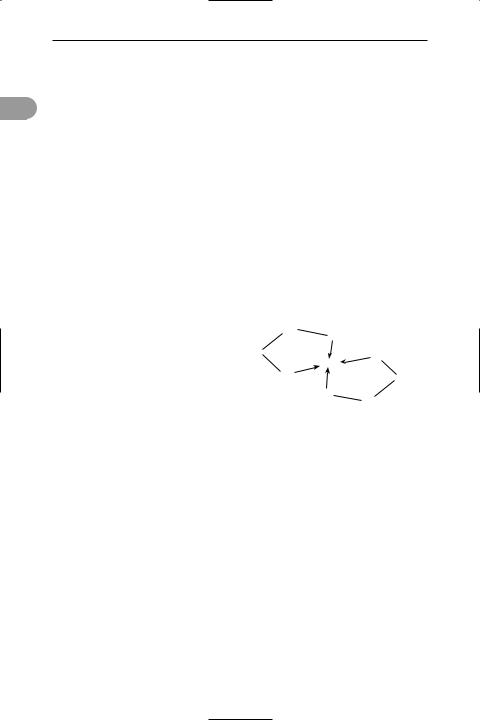
A Dictionary of Science
.pdf
cell division |
146 |
the cell doubles and the chromosomes replicate; (4) the G2 phase, during which the Ünal preparations for cell division are made. *Interphase consists of the G1, S,
cand G2 phases, which comprise about 90% (16–24 hours) of the total time of the cell cycle in rapidly dividing cells. The M phase lasts about 1–2 hours. A point is
reached in the G1 phase, known as the restriction point, after which the cell becomes committed to passing through the remainder of the cell cycle regardless of the external conditions.
cell division The formation of two or
more daughter cells from a single mother cell. The nucleus divides Ürst and this is followed by the formation of a plasma membrane between the daughter nuclei. *Mitosis produces two daughter nuclei that are identical to the original nucleus; *meiosis results in four daughter nuclei each with half the number of chromosomes in the mother cell nucleus. See also cell cycle.
cell fusion (somatic cell hybridization)
The technique of combining two cells from different tissues or species in a cell culture. The cells fuse and coalesce but their nuclei generally remain separate. However, during cell division a single spindle is formed so that each daughter cell has a single nucleus containing sets of chromosomes from each parental line. Subsequent division of the hybrid cells often results in the loss of chromosomes (and therefore genes), so that absence of a gene product in the culture can be related to the loss of a particular chromosome. Thus the technique is used to determine
the control of characteristics exerted by speciÜc chromosomes. Hybrid cells resulting from cell fusion have also been used to produce *monoclonal antibodies.
cell junction Any of various kinds of connection between cells. Tight junctions form a seal between adjacent cells, particularly in epithelia, to prevent the passage of materials between cells. A primarily structural bond between cells is provided by adherens junctions and desmosomes, whereas communication between adjacent cells is facilitated by gap junctions in animal cells and *plasmodesmata in plant cells.
cell membrane Any membrane that is found in a living cell, especially the *plasma membrane, which forms the cell boundary. Other cell membranes include the nuclear envelope (see nucleus); the *tonoplast, which encloses the vacuole of plant cells; and the membranes of the various cell organelles, such as the endoplasmic reticulum, Golgi apparatus, mitochondria, chloroplasts, and lysosomes.
cell sap The solution that Ülls the vacuoles of plant cells. It contains sugars, amino acids, waste substances (such as tannins), and mineral salts.
cell theory The theory that was born of the Ündings of Matthias Schleiden (1804– 81) in 1838 and Theodor *Schwann in 1839, who postulated, respectively, that plants and animals were made up of cells and that these units were basic to the structure and function of all organisms. Previously, in 1665, Robert Hooke, while examining cork under the microscope, had observed that its structure consisted of hollow boxlike units, which he called ‘cells’. At the time, however, he did not realize the signiÜcance of these units, which were in fact dead cells.
cellular plastics Solid synthetic materials having an open structure. A common example is rigid *polystyrene foam used in insulation and packaging.
cellulase A carbohydrate-digesting enzyme (a carbohydrase) that hydrolyses cellulose to sugars, including cellobiose (a disaccharide consisting of two β-(1,4) linked molecules of glucose) and glucose. Cellulase breaks the β-glycosidic links that join the constituent sugar units of cellulose. See also ruminantia.
celluloid A transparent highly Ûammable substance made from cellulose nitrate with a camphor plasticizer. It was formerly widely used as a thermoplastic material, especially for Ülm (a use now discontinued owing to the Ûammability of celluloid).
cellulose A polysaccharide that consists of a long unbranched chain of glucose units. It is the main constituent of the cell walls of all plants, many algae, and some fungi and is responsible for providing the

147 |
Central Dogma |
rigidity of the cell wall. It is an important constituent of dietary *Übre. The Übrous nature of extracted cellulose has led to its use in the textile industry for the production of cotton, artiÜcial silk, etc.
cellulose acetate See cellulose ethanoate.
cellulose ethanoate (cellulose acetate)
A compound prepared by treating cellulose (cotton linters or wood pulp) with a mixture of ethanoic anhydride, ethanoic acid, and concentrated sulphuric acid. Cellulose in the cotton is ethanoylated and when the resulting solution is treated with water, cellulose ethanoate forms as a Ûocculent white mass. It is used in lacquers, nonshatterable glass, varnishes, and as a Übre (see also rayon).
cellulose nitrate A highly Ûammable material made by treating cellulose (wood pulp) with concentrated nitric acid. Despite the alternative name nitrocellulose, the compound is in fact an ester (containing CONO2 groups), not a nitro compound (which would contain C–NO2). It is used in explosives (as guncotton) and celluloid.
cell wall A rigid outer layer that surrounds the plasma membrane of plant, fungal, algal and bacterial (but not animal) cells. It protects and/or gives shape to a cell, and in herbaceous plants provides mechanical support for the plant body. Most plant cell walls are composed of the polysaccharide *cellulose and may be strengthened by the addition of *lignin. The cell walls of fungi consist mainly of *chitin. Bacterial cell walls consist of complex polymers of polysaccharides and amino acids.
Celsius scale A *temperature scale in which the Üxed points are the temperatures at standard pressure of ice in equilibrium with water (0°C) and water in equilibrium with steam (100°C). The scale, between these two temperatures, is divided in 100 degrees. The degree Celsius (°C) is equal in magnitude to the *kelvin. This scale was formerly known as the centigrade scale; the name was ofÜcially changed in 1948 to avoid confusion with a hundredth part of a grade. It is named after the Swedish astronomer Anders Celsius (1701–44), who devised the inverted
form of this scale (ice point 100°, steam point 0°) in 1742.
cement 1. Any of various substances used for bonding or setting to a hard ma-
terial. Portland cement is a mixture of cal- c cium silicates and aluminates made by
heating limestone (CaCO3) with clay (containing aluminosilicates) in a kiln. The product is ground to a Üne powder. When mixed with water it sets in a few hours and then hardens over a longer period of time due to the formation of hydrated aluminates and silicates. 2. (cementum) A thin layer of bony material that Üxes teeth to the jaw. It covers the dentine of the root of a *tooth, below the level of the gum, and is attached to the *periodontal membrane lining the tooth socket in the jawbone.
cementation Any metallurgical process in which the surface of a metal is impregnated by some other substance, especially an obsolete process for making steel by heating bars of wrought iron to red heat for several days in a bed of charcoal. See also case hardening.
cementite See steel.
Cenozoic (Cainozoic; Kainozoic) The geological era that began about 65 million years ago and extends to the present. It followed the *Mesozoic era and is subdivided into the *Tertiary and *Quaternary periods. The Cenozoic is often known as the Age of Mammals as these animals evolved to become an abundant, diverse, and dominant group. Birds and Ûowering plants also Ûourished. The era saw the formation of the major mountain ranges of the Himalayas and the Alps.
centi- Symbol c. A preÜx used in the metric system to denote one hundredth. For example, 0.01 metre = 1 centimetre (cm).
centigrade scale See celsius scale.
centipedes See chilopoda.
Central Dogma The basic belief originally held by molecular geneticists, that Ûow of genetic information can only occur from *DNA to *RNA to proteins. It is now known, however, that information contained within RNA molecules can also Ûow back to DNA, for example during the

central nervous system |
148 |
replication of *retroviruses. See also genetic code.
central nervous system (CNS) The part of the nervous system that coordi-
cnates all neural functions. In invertebrates it may comprise simply a few *nerve cords and their associated *ganglia. In vertebrates it consists of the *brain and the
*spinal cord. The vertebrate CNS contains *reÛex arcs, which produce automatic and rapid responses to particular stimuli.
central processing unit See cpu; computer.
centre (in neurology) A part of the nervous system, consisting of a group of nerve cells, that coordinates a particular process. An example is the respiratory centre in the vertebrate brainstem, which controls breathing movements. The stimulation of a centre will initiate the process, while destruction of the centre will prevent or impair it.
centre of curvature The centre of the sphere of which a *lens surface or curved *mirror forms a part. The radius of curvature is the radius of this sphere.
centre of gravity See centre of mass.
centre of mass The point at which the whole mass of a body may be considered to be concentrated. This is the same as the centre of gravity, the point at which the whole weight of a body may be consid-
ered to act, if the body is situated in a uniform gravitational Üeld.
centrifugal force See centripetal force.
centrifugal pump See pump.
centrifuge A device in which solid or liquid particles of different densities are separated by rotating them in a tube in a horizontal circle. The denser particles tend to move along the length of the tube to a greater radius of rotation, displacing the lighter particles to the other end.
centriole A cylindrical structure associated with the *centrosome in animal cells but not normally found in plant cells.
Centrioles occur in pairs, orientated at right angles to each other, and are composed of *microtubules. During cell division the pair separates: a centriole
migrates with each centrosome to opposite poles of the cell. It was formerly thought that centrioles were involved in the assembly of *spindle microtubules but this is now in doubt, since their absence does not affect spindle formation.
centripetal force A force acting on a body causing it to move in a circular path. If the mass of the body is m, its constant speed v, and the radius of the circle r, the magnitude of the force is mv2/r and it is directed towards the centre of the circle. Even though the body is moving with a constant speed v, its velocity is changing, because its direction is constantly changing. There is therefore an acceleration v2/r towards the centre of the circle. For example, when an object is tied to a string and swung in a horizontal circle there is a tension in the string equal to mv2/r. If the string breaks, this restraining force disappears and the object will move off in a straight line along the tangent to the circle in which it was previously moving.
In the case of a satellite (mass m) orbiting the earth (mass M), the centripetal force holding the satellite in orbit is the gravitational force, GmM/d2, where G is the gravitational constant and d is the height of the satellite above the centre of the earth. Therefore GmM/d2 = mv2/d. This equation enables the height of the orbit to be calculated for a given orbital velocity.
Another way of looking at this situation, which was once popular, is to assume that the centripetal force is balanced by an equal and opposite force, acting away from the centre of the circle, called the centrifugal force. One could then say that the satellite stays in orbit when the centrifugal force balances the gravitational force. This is, however, a confusing and misleading argument because the centrifugal force is Üctitious – it does not exist. The gravitational force is not balanced by the centrifugal force: it is the centripetal force.
Another example is that of a car rounding a bend. To an observer in the car, a tennis ball lying on the back shelf will roll across the shelf as if it was acted on by an outward centrifugal force. However, to an observer outside the car it can be seen that the ball, because of its almost fric-

149 |
cerebrospinal fluid |
tionless contact with the car, is continuing in its straight line motion, uninÛuenced by the centripetal force. Occasionally the concept of a centrifugal force can be useful, as long as it is recognized as a Üctitious force. A true centrifugal force is exerted, as a *reaction, by the rotating object on whatever is providing its centripetal force.
centroid The point within an area or volume at which the centre of mass would be if the surface or body had a uniform density. For a symmetrical area or volume it coincides with the centre of mass. For a nonsymmetrical area or volume it has to be found by integration.
centromere (kinomere; spindle attachment) The part of a *chromosome that attaches to the *spindle during cell division (see meiosis; mitosis), attachment being via a platelike structure called the *kinetochore. The centromere usually appears as a constriction when chromosomes contract during cell division. The position of the centromere is a distinguishing feature of individual chromosomes.
centrosome (cell centre; centrosphere) A specialized region of all eukaryote cells except fungi, situated next to the nucleus, that organizes the microtubules of the *spindle during cell division. In animal cells it is also the main region of the cell from which the microtubules of the *cytoskeleton radiate. The centrosomes of most animal cells contain a pair of *centrioles. During *metaphase of mitosis and meiosis, the centrosome separates into two regions, each containing one of the centrioles (where present). The two regions move to opposite ends of the cell and a spindle forms between them. See also aster.
centrum See vertebra.
cephalization The tendency among animal groups for the major sense organs, mouth, and brain to be grouped together at the front (anterior) end of the body. These are usually contained in a specialized cephalic region – the head.
Cephalopoda The most advanced class of molluscs, containing the squids, cuttleÜshes, octopuses, and the extinct
*ammonites. Cephalopods have a highly concentrated central nervous system within a protective cartilaginous case. The eye has a well-developed retina and is
comparable to that of vertebrates. All c cephalopods are predacious carnivores ca-
pable of swimming by jet propulsion; they have highly mobile tentacles for catching and holding prey.
cephalothorax The fused head and thorax of crustaceans and arachnids (spiders, scorpions), which is connected to the abdomen.
Cepheid variable An unstable pulsating star that has left the main sequence (see hertzsprung–russell diagram). As it pulsates every 3 to 50 days its luminosity, radius, and temperature vary in a regular way. Most Cepheids are yellow supergiants and will become *red giants. There are more than 700 known Cepheids, named after their prototype, Delta Cepheid in the northern constellation Cepheus.
ceramics Inorganic materials, such as pottery, enamels, and refractories. Ceramics are metal silicates, oxides, nitrides, etc.
cerebellum The part of the vertebrate *brain concerned with the coordination and regulation of muscle activity and the maintenance of muscle tone and balance. In mammals it consists of two connected hemispheres, composed of a core of white matter and a much-folded outer layer of grey matter, and is situated above the medulla oblongata and partly beneath the cerebrum.
cerebral cortex (pallium) The layer of
*grey matter that forms the outer layer of the hemispheres of the *cerebrum in many vertebrates. It is most highly developed in mammals. The cortex is responsible for the control and integration of voluntary movement and the senses of vision, hearing, touch, etc.; it also contains centres concerned with memory, language, thought, and intellect.
cerebral hemisphere Either of the two halves of the vertebrate *cerebrum.
cerebrospinal Ûuid (CSF) The Ûuid, similar in composition to *lymph, that bathes the central nervous system of ver-

cerebrum |
150 |
tebrates. It is secreted by the *choroid plexus into the *ventricles of the brain, Ülling these and other cavities in the brain and spinal cord, and is reabsorbed
cby veins on the brain surface. Its function is to protect the central nervous system from mechanical injury.
cerebrum The largest part of the vertebrate *brain. It consists of two cerebral hemispheres, which develop from the embryonic *forebrain. The hemispheres have an outer convoluted layer of grey matter – the *cerebral cortex – which contains an estimated ten billion nerve cells. Underneath this is *white matter. The two halves of the cerebrum are linked by the *corpus callosum. The function of the cerebrum is to integrate complex sensory and neural functions. The cerebrum is thought to play a critical role in the process of learning, which involves both short-term and long-term memory.
Cerenkov, Pavel Alekseyevich
(1904–90) Soviet physicist, who became a professor at the Lebedev Institute of Physics in Moscow. In 1934, while observing radioactive radiation underwater, he discovered *Cerenkov radiation. The explanation of the phenomenon was provided by Igor Tamm (1895–1971) and Ilya Frank (1908–90), and in 1958 the three scientists shared the Nobel Prize for physics.
Cerenkov counter (Cerenkov detector)
A type of *counter for detecting and counting high-energy charged particles. The particles pass through a liquid and the light emitted as *Cerenkov radiation is registered by a *photomultiplier tube.
Cerenkov radiation Electromagnetic radiation, usually bluish light, emitted by a beam of high-energy charged particles passing through a transparent medium at a speed greater than the speed of light in that medium. It was discovered in 1934 by Pavel Cerenkov. The effect is similar to that of a *sonic boom when an object moves faster than the speed of sound; in
this case the radiation is a shock wave set up in the electromagnetic Üeld. Cerenkov radiation is used in the *Cerenkov counter.
cerium Symbol Ce. A silvery metallic el-
ement belonging to the *lanthanoids; a.n. 58; r.a.m. 140.12; r.d. 6.77 (20°C); m.p.
799°C; b.p. 3426°C. It occurs in allanite, bastnasite, cerite, and monazite. Four isotopes occur naturally: cerium–136, –138, –140, and –142; Üfteen radioisotopes have been identiÜed. Cerium is used in mischmetal, a rare-earth metal containing 25% cerium, for use in lighter Ûints. The oxide is used in the glass industry. It was discovered by Martin Klaproth (1743–1817) in 1803.
cermet A composite material consisting of a ceramic in combination with a sintered metal, used when a high resistance to temperature, corrosion, and abrasion is needed.
CERN (Conseil Européen pour la Recherche Nucléaire) The European Laboratory for Particle Physics, formerly known as the European Organization for Nuclear Research, which is situated close to Geneva in Switzerland and is supported by a number of European nations. It runs the Super Proton Synchrotron (SPS), which has a 7-kilometre underground tunnel enabling protons to be accelerated to
400 GeV, and the Large Electron-Positron Collider (LEP), in which 50 GeV electron and positron beams are collided.
cerussite An ore of lead consisting of lead carbonate, PbCO3. It is usually of secondary origin, formed by the weathering of *galena. Pure cerussite is white but the mineral may be grey due to the presence of impurities. It forms well-shaped orthorhombic crystals. It occurs in the USA, Spain, and SW Africa.
cervical vertebrae The *vertebrae of the neck. The number of cervical vertebrae varies with the vertebrate group: most mammals (including humans) have seven. Their main functions are to support the head and to provide articulating surfaces against which it can move relative to the backbone. See atlas; axis.
cervix A narrow or necklike part of an organ. The cervix of the uterus (cervix uteri) leads to the vagina. Glands in its walls produce mucus, whose viscosity changes according to the oestrous cycle. During labour, the cervix enlarges greatly to allow passage of the fetus.
Cestoda A class of Ûatworms (see platyhelminthes) comprising the tapeworms –

151 |
chain reaction |
ribbon-like parasites within the gut of vertebrates. Tapeworms are surrounded by partially digested food in the host gut so they are able to absorb nutrients through their whole body surface. The body consists of a scolex (head), bearing suckers and hooks for attachment, and a series of proglottids, which contain male and female reproductive systems. The life cycle of a tapeworm requires two hosts, the primary host usually being a predator of the secondary host. Taenia solium has humans for its primary host and the pig as its secondary host. Mature proglottids, containing thousands of fertilized eggs, leave the primary host with its faeces and develop into embryos and then larvae that continue the life cycle in the gut of a secondary host.
Cetacea An order of marine mammals comprising the whales, which includes what is probably the largest known animal – the blue whale (Balaenoptera musculus), over 30 m long and over 150 tonnes in weight. The forelimbs of whales are modiÜed as short stabilizing Ûippers and the skin is very thin and almost hairless. A thick layer of blubber insulates the body against heat loss and is an important food store. Whales breathe through a dorsal blowhole, which is closed when the animal is submerged. The toothed whales (suborder Odontoceti), such as the dolphins and killer whale, are carnivorous; whalebone whales (suborder Mysticeti), such as the blue whale, feed on plankton Ültered by *whalebone plates.
cetane See hexadecane.
cetane number A number that provides a measure of the ignition characteristics of a Diesel fuel when it is burnt in a standard Diesel engine. It is the percentage of cetane (hexadecane) in a mixture of cetane and 1-methylnaphthalene that has the same ignition characteristics as the fuel being tested. Compare octane number.
CFC See chlorofluorocarbon.
c.g.s. units A system of *units based on the centimetre, gram, and second. Derived from the metric system, it was not well suited for use with thermal quantities (based on the inconsistently deÜned
*calorie) and with electrical quantities (in which two systems, based respectively on unit permittivity and unit permeability of free space, were used). For many scientiÜc
purposes c.g.s. units have now been re- c placed by *SI units.
Chadwick, Sir James (1891–1974) British physicist. After working at Manchester University under *Rutherford, he went to work with Hans *Geiger in Leipzig in 1913. Interned for the duration of World War I, he joined Rutherford in Cambridge after the war. In 1932 he discovered the *neutron, as predicted by Rutherford. In 1935 he was awarded the Nobel Prize, the same year in which he built Britain’s Ürst *cyclotron at Liverpool University.
chaeta A bristle, made of *chitin, occurring in annelid worms. In the earthworm they occur in small groups projecting from the skin in each segment and function in locomotion. The chaetae of polychaete worms (e.g. ragworm) are borne in larger groups on paddle-like appendages (parapodia).
chain A line of atoms of the same type in a molecule. In a straight chain the atoms are attached only to single atoms, not to groups. Propane, for instance, is a straight-chain alkane, CH3CH2CH3, with a chain of three carbon atoms. A branched chain is one in which there are side groups attached to the chain. Thus,
3-ethyloctane, CH3CH2CH(C2H5)C5H11, is a branched-chain alkane in which there is a
side chain (C2H5) attached to the third carbon atom. A closed chain is a *ring of atoms in a molecule; otherwise the molecule has an open chain.
Chain, Sir Ernst Boris (1906–79) Ger- man-born British biochemist, who began his research career at Cambridge University in 1933. Two years later he joined *Florey at Oxford, where they isolated and puriÜed *penicillin. They also developed a method of producing the drug in large quantities and carried out its Ürst clinical trials. The two men shared the 1945 Nobel Prize for physiology or medicine with penicillin’s discoverer, Alexander *Fleming.
chain reaction A reaction that is self-

chair conformation |
152 |
sustaining as a result of the products of one step initiating a subsequent step.
In nuclear chain reactions the succession depends on production and capture
cof neutrons. Thus, one nucleus of the isotope uranium–235 can disintegrate with
the production of two or three neutrons, which cause similar Üssion of adjacent nuclei. These in turn produce more neutrons. If the total amount of material exceeds a *critical mass, the chain reaction may cause an explosion.
Chemical chain reactions usually involve free radicals as intermediates. An example is the reaction of chlorine with
hydrogen initiated by ultraviolet radiation. A chlorine molecule is Ürst split into atoms:
Cl2 → Cl· + Cl·
These react with hydrogen as follows
Cl· + H2 → HCl + H·
H· + Cl2 → HCl + Cl· etc.
Combustion and explosion reactions involve similar free-radical chain reactions.
chair conformation See conformation.
chalaza 1. A twisted strand of Übrous albumen in a bird’s egg that is attached to the membrane at either end of the yolk and thus holds the yolk in position in the albumen. 2. The part of a plant *ovule where the nucellus and integuments merge.
chalcedony A mineral consisting of a microcrystalline variety of *quartz. It occurs in several forms, including a large number of semiprecious gemstones; for example, sard, carnelian, jasper, onyx, chrysoprase, agate, and tiger’s-eye.
chalcogens See group 16 elements.
chalconides Binary compounds formed between metals and group 16 elements; i.e. oxides, sulphides, selenides, and tellurides.
chalcopyrite (copper pyrites) A brassy yellow mineral consisting of a mixed cop- per–iron sulphide, CuFeS2, crystallizing in the tetragonal system; the principal ore of copper. It is similar in appearance to pyrite and gold. It crystallizes in igneous
rocks and hydrothermal veins associated with the upper parts of acid igneous intrusions. Chalcopyrite is the most widespread of the copper ores, occurring, for example, in Cornwall (UK), Sudbury (Canada), Chile, Tasmania (Australia), and Rio Tinto (Spain).
chalk A very Üne-grained white rock composed of the fossilized skeletal remains of marine plankton known as coccoliths and consisting largely of *calcium carbonate (CaCO3). It is used in toothpaste and cosmetics and is the characteristic rock of the *Cretaceous period. It should not be confused with blackboard ‘chalk’, which is made from calcium sulphate.
Chandrasekhar limit The maximum possible mass of a star that is prevented from collapsing under its own gravity by the *degeneracy pressure of electrons. For white dwarfs the Chandrasekhar mass is about 1.4 times the mass of the sun. There is an analogue of the Chandrasekhar limit for neutron stars. For neutron stars its value is less precisely known because of uncertainties regarding the equation of state of neutron matter, but it is generally taken to be in the range of 1.5 to 3 (and almost certainly no more than 5) times the mass of the sun. It is named after Subrahmanyan Chandrasekhar (1910–95).
change of phase (change of state) A change of matter in one physical *phase (solid, liquid, or gas) into another. The change is invariably accompanied by the evolution or absorption of energy, even if it takes place at constant temperature (see latent heat).
channel 1. The region between the source and the drain in a Üeld-effect *transistor. The conductivity of the channel is controlled by the voltage applied to the gate. 2. A path, or a speciÜed frequency band, along which signals, information, or data Ûow. 3. A pore formed by a protein molecule in a plasma membrane that aids the diffusion of certain substances into and out of the cell. These substances are usually charged ions (see ion channel) or lipid-insoluble molecules. See also transport protein.
chaos Unpredictable and seemingly random behaviour occurring in a system that

153 |
charge density |
should be governed by deterministic laws. In such systems, the equations that describe the way the system changes with time are nonlinear and involve several variables. Consequently, they are very sensitive to the initial conditions, and a very small initial difference may make an enormous change to the future state of the system. Originally, the theory was introduced to describe unpredictability in meteorology, as exempliÜed by the butterÛy effect. It has been suggested that the dynamical equations governing the weather are so sensitive to the initial data that whether or not a butterÛy Ûaps its wings in one part of the world may make the difference between a tornado occurring or not occurring in some other part of the world. Chaos theory has subsequently been extended to other branches of science; for example to turbulent Ûow, planetary dynamics, and electrical oscillations in physics, and to combustion processes and *oscillating reactions in chemistry. See also attractor; fractal.
chaotic reaction A type of chemical reaction in which the concentrations of reactants show chaotic behaviour. This may occur when the reaction involves a large number of complex interlinked steps. Under such conditions, it is possible for the reaction to display unpredictable changes with time. See also oscillating reaction.
character (trait) A distinctive inherited feature of an organism. Organisms in a population may display different aspects of a particular character, e.g. the A, B, and O human blood groups (see abo system) are different aspects of the blood group character.
characteristic See logarithm.
charcoal A porous form of carbon produced by the destructive distillation of organic material. Charcoal from wood is used as a fuel. All forms of charcoal are porous and are used for adsorbing gases and purifying and clarifying liquids. There are several types depending on the source. Charcoal from coconut shells is a particularly good gas adsorbent. Animal charcoal (or bone black) is made by heating bones and dissolving out the calcium phosphates and other mineral salts with acid.
It is used in sugar reÜning. Activated char- |
|
|
coal is charcoal that has been activated for |
|
|
adsorption by steaming or by heating in a |
|
|
vacuum. |
|
|
|
|
|
charge A property of some *elementary |
c |
|
particles that gives rise to an interaction |
|
|
between them and consequently to the |
|
|
host of material phenomena described as |
|
|
electrical. Charge occurs in nature in two |
|
|
forms, conventionally described as posi- |
|
|
tive and negative in order to distinguish |
|
|
between the two kinds of interaction be- |
|
|
tween particles. Two particles that have |
|
|
similar charges (both negative or both |
|
|
positive) interact by repelling each other; |
|
|
two particles that have dissimilar charges |
|
|
(one positive, one negative) interact by at- |
|
|
tracting each other. The size of the inter- |
|
|
action is determined by *Coulomb’s law. |
|
|
The natural unit of negative charge is |
|
|
the charge on an *electron, which is |
|
|
equal but opposite in effect to the positive |
|
|
charge on the proton. Large-scale matter |
|
|
that consists of equal numbers of elec- |
|
|
trons and protons is electrically neutral. If |
|
|
there is an excess of electrons the body is |
|
|
negatively charged; an excess of protons |
|
|
results in a positive charge. A Ûow of |
|
|
charged particles, especially a Ûow of elec- |
|
|
trons, constitutes an electric current. |
|
|
Charge is measured in coulombs, the |
|
|
charge on an electron being 1.602 × 10–19 |
|
|
coulombs. |
|
|
charge carrier The entity that trans- |
|
|
ports electric charge in an electric cur- |
|
|
rent. The nature of the carrier depends on |
|
|
the type of conductor: in metals, the |
|
|
charge carriers are electrons; in *semicon- |
|
|
ductors the carriers are electrons (n-type) |
|
|
or positive *holes (p-type); in gases the |
|
|
carriers are positive ions and electrons; in |
|
|
electrolytes they are positive and negative |
|
|
ions. |
|
|
charge conjugation Symbol C. A prop- |
|
|
erty of elementary particles that deter- |
|
|
mines the difference between a particle |
|
|
and its *antiparticle. The property is not |
|
|
restricted to electrically charged particles |
|
|
(i.e. it applies to neutral particles such as |
|
|
the neutron). See cp invariance. |
|
|
charge density 1. The electric charge |
|
|
per unit volume of a medium or body |
|
|
(volume charge density). 2. The electric |
|
|

charge-transfer complex |
154 |
charge per unit surface area of a body (surface charge density).
charge-transfer complex A chemical compound in which there is weak coordi-
cnation involving the transfer of charge between two molecules. An example is phenoquinone, in which the phenol and quinone molecules are not held together by formal chemical bonds but are associated by transfer of charge between the compounds’ aromatic ring systems.
Charles, Jacques Alexandre César
(1746–1823) French chemist and physicist, who became professor of physics at the Paris Conservatoire des Arts et Métiers. He is best remembered for discovering *Charles’ law (1787), relating to the vol-
ume and temperature of a gas. In 1783 he became the Ürst person to make an ascent in a hydrogen balloon.
Charles’ law The volume of a Üxed
mass of gas at constant pressure expands by a constant fraction of its volume at 0°C for each Celsius degree or kelvin its temperature is raised. For any *ideal gas the fraction is approximately 1/273. This can be expressed by the equation
V = V0(1 + t/273),
where V0 is the volume at 0°C and V is its volume at t°C. This is equivalent to the statement that the volume of a Üxed mass of gas at constant pressure is proportional to its thermodynamic temperature, V = kT, where k is a constant. The law resulted from experiments begun around 1787 by Jacques Charles but was properly established only by the more accurate results published in 1802 by the French scientist Joseph Gay-Lussac (1778–1850). Thus the law is also known as Gay-Lussac’s law. An equation similar to that given above applies to pressures for ideal gases:
p = p0(1 + t/273),
a relationship known as Charles’ law of pressures. See also gas laws.
charm A property of certain *elementary particles that is expressed as a quantum number and is used in the quark model. It was originally suggested to account for the unusually long lifetime of the *psi particle. In this theory the three original quark–antiquark pairs were sup-
plemented by a fourth pair – the charmed quark and its antiquark. The psi particle itself is a meson having zero charm as it consists of the charmed pair. However, charmed *hadrons do exist; they are said to possess naked charm. Charm is thought to be conserved in strong and electromagnetic interactions.
cheddite Any of a group of high explosives made from nitro compounds mixed with sodium or potassium chlorate.
chelate An inorganic complex in which a *ligand is coordinated to a metal ion at two (or more) points, so that there is a ring of atoms including the metal (see formula). The process is known as chelation. A ligand such as diaminoethane, which coordinates at two points, is said to be bidentate (‘having two teeth’). Other ligands are tridentate, tetradentate, etc. The angle made by two bonds coordinating
to the metal atom is the bite angle of the ligand. See also sequestration.
|
H2C |
NH2 |
|
|
|
|
|
H2C |
|
Cu2+ |
NH2 |
|
|
||
|
|
|
|
|
NH2 |
|
CH2 |
|
|
|
|
|
|
NH2 |
CH2 |
|
|
|
Chelate formed by coordination of two molecules of H2N(CH2)2NH2
chelicerae The Ürst pair of appendages on the head of arachnids and other *arthropods of the phylum Chelicerata. These appendages take the form of pincers or claws and are used for grasping or tearing food.
chemical bond A strong force of attraction holding atoms together in a molecule or crystal. Typically chemical bonds have energies of about 1000 kJ mol–1 and are distinguished from the much weaker forces between molecules (see van der waals’ force). There are various types.
Ionic (or electrovalent) bonds can be formed by transfer of electrons. For instance, the calcium atom has an electron conÜguration of [Ar]4s2, i.e. it has two electrons in its outer shell. The chlorine atom is [Ne]3s23p5, with seven outer elec-

155 |
chemical dating |
trons. If the calcium atom transfers two electrons, one to each chlorine atom, it becomes a Ca2+ ion with the stable conÜguration of an inert gas [Ar]. At the same time each chlorine, having gained one electron, becomes a Cl– ion, also with an inert-gas conÜguration [Ar]. The bonding in calcium chloride is the electrostatic attraction between the ions.
Covalent bonds are formed by sharing of valence electrons rather than by transfer. For instance, hydrogen atoms have one outer electron (1s1). In the hydrogen molecule, H2, each atom contributes 1 electron to the bond. Consequently, each hydrogen atom has control of 2 electrons
– one of its own and the second from the other atom – giving it the electron conÜguration of an inert gas [He]. In the water molecule, H2O, the oxygen atom, with six outer electrons, gains control of an extra two electrons supplied by the two hydrogen atoms. This gives it the conÜguration [Ne]. Similarly, each hydrogen atom gains control of an extra electron from the oxygen, and has the [He] electron conÜguration.
A particular type of covalent bond is one in which one of the atoms supplies both the electrons. These are known as coordinate (semipolar or dative) bonds, and written A→B, where the direction of the arrow denotes the direction in which electrons are donated.
Covalent or coordinate bonds in which one pair of electrons is shared are elec- tron-pair bonds and are known as single bonds. Atoms can also share two pairs of electrons to form double bonds or three pairs in triple bonds. See orbital.
In a compound such as sodium chloride, Na+Cl–, there is probably complete transfer of electrons in forming the ionic bond (the bond is said to be heteropolar). Alternatively, in the hydrogen molecule H–H, the pair of electrons is equally shared between the two atoms (the bond is homopolar). Between these two extremes, there is a whole range of intermediate bonds, which have both ionic and covalent contributions. Thus, in hydrogen chloride, H–Cl, the bonding is predominantly covalent with one pair of electrons shared between the two atoms. However, the chlorine atom is more electronegative than the hydrogen and has more control
over the electron pair; i.e. the molecule is polarized with a positive charge on the hydrogen and a negative charge on the chlorine. See also banana bond; hydrogen
bond; metallic bond; multicentre c bond; multiple bond.
chemical cell See cell.
chemical combination The combination of elements to give compounds. There are three laws of chemical combination.
(1)The law of constant composition states that the proportions of the elements in a compound are always the same, no matter how the compound is made. It is also
called the law of constant proportions or deÜnite proportions.
(2)The law of multiple proportions states that when two elements A and B combine
to form more than one compound, then the masses of B that combine with a Üxed mass of A are in simple ratio to one another. For example, carbon forms two oxides. In one, 12 grams of carbon is combined with 16 grams of oxygen (CO); in the other 12 grams of carbon is combined
with 32 grams of oxygen (CO2). The oxygen masses combining with a Üxed mass of carbon are in the ratio 16:32, i.e. 1:2.
(3)The law of equivalent proportions states that if two elements A and B each form a compound with a third element C, then a compound of A and B will contain A and B in the relative proportions in which they react with C. For example, sulphur and carbon both form compounds with hydrogen. In methane 12 g of carbon react with 4 g of hydrogen. In hydrogen sulphide, 32 g of sulphur react with 2 g of hydrogen (i.e. 64 g of S for 4 g of hydrogen). Sulphur and carbon form a compound in which the C:S ratio is 12:64 (i.e.
CS2). The law is sometimes called the law of reciprocal proportions.
chemical control The use of chemicals to kill pests (see pesticide). Compare biological control.
chemical dating An absolute *dating technique that depends on measuring the chemical composition of a specimen. Chemical dating can be used when the specimen is known to undergo slow chemical change at a known rate. For instance, phosphate in buried bones is
